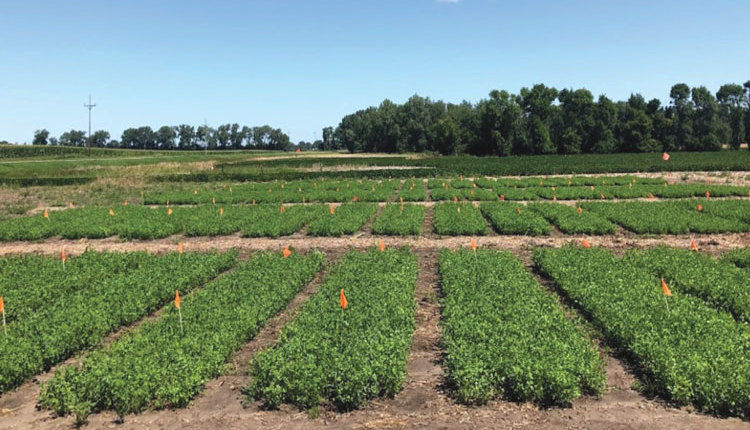Reducing potassium deficiency |
| By Hay and Forage Grower |
|
|
|
Hay & Forage Grower is featuring results of research projects funded through the Alfalfa Checkoff, officially named the U.S. Alfalfa Farmer Research Initiative, administered by National Alfalfa & Forage Alliance (NAFA). The checkoff program facilitates farmer-funded research.  Smectite and illite clay soils were tested for potassium fertilizer’s effect on alfalfa yield, quality, and persistence. Potassium deficiency is largely to blame for nearly 90% of the stand losses in an alfalfa stand’s fourth year after establishment in North Dakota, said Marisol Berti. The North Dakota State University (NDSU) forage and biomass crop production researcher is working to reduce those losses. Her efforts on two research projects — funded by National Alfalfa & Forage Alliance’s Alfalfa Checkoff and the National Institute of Food and Agriculture (NIFA) — show farmers it pays to apply potassium fertilizer to alfalfa. That research may also allow them to use less fertilizer, save costs, improve winter survival, and boost alfalfa yields. Checkoff research is looking at potassium fertilizer’s effect on alfalfa yield, quality, and persistence, comparing three fall dormancies, varied rates of application, and harvest stress on soils with different smectite-to-illite ratios.  Marisol Berti, NDSU $37,270 For alfalfa to be persistent and high yielding, supplemental K is needed, particularly on higher clay-ratio soils. But many farmers aren’t applying K — even though harvested alfalfa removes about 50 pounds of it per ton of dry matter, Berti said. Early spring release of K from soils will supply first-cutting alfalfa, but more K is needed in later cuttings. For alfalfa, the critical soil test K level of 200 parts per million (ppm) is needed in soils with the greater-than-3.5-smectite/illite ratio, and 150 ppm in soils with the lower ratio. Two farmers, one with high-smectite fields and one with a low-smectite area, let Berti plant alfalfa experiments on their land. Both soils were also very low in potassium, averaging about 100 parts per million (ppm). “With only seeding-year results, I wasn’t expecting much of a forage yield difference,” Berti said. “But we anticipate next year we will find differences in forage yield among treatments. We didn’t expect that potassium changed the quality of alfalfa, but it increased ash content and lowered total digestible nutrients (TDN). I think, when you fertilize with high rates of K, you have higher deposition of K in stems and possibly a higher stem-to-leaf ratio,” she added. Currently, one of Berti’s students is analyzing roots collected for carbohydrate and protein levels, because K plays an important role on translocation of photosynthates from the tops of plants to roots for winter. Berti is seeing more soils with K deficiency and greater alfalfa winterkill and hopes her research will convince farmers that fertilizing alfalfa with potassium in K-deficient soils is profitable. The spring 2020 soil sampling showed that even where 300 pounds per acre of potassium oxide (K2O) treatments were applied in 2019, soil test levels remained at about the same level as plots without K application — approximately 100 to 120 ppm of available K. “The removal of K by alfalfa biomass in two cuts last year only explains less than half of the rate of K applied. We will analyze nonextractable potassium in soils to determine if high-smectite clay soils are immobilizing K in the clay layers,” Berti explained. Microbiome impact The NIFA research, funded through the Alfalfa Seed and Alfalfa Forage Systems Research Program, was built on the Checkoff research. It looks at how fertility treatments and varieties affect the soil microbiome, a general term describing all microorganisms found in soil. Berti and Heike Bücking, South Dakota State University biologist and microbiologist, are investigating arbuscular mycorrhizal fungal communities within the microbiome that can help move K toward plants. “Arbuscular mycorrhizae (AM) provides an extra radical network that allows alfalfa plants to scavenge nutrients further than their root systems allow and go into those layers within the clays to take potassium out,” Berti explained. “It’s a really interesting and new concept. We’re excited because the interaction of alfalfa with AM is not well-known, and we do not really know which AM fungal communities are colonizing alfalfa in the Upper Midwest.” Project Results: Seeding-year findings show potassium fertilization increased ash content and lowered TDN. Potassium may increase alfalfa’s stem-to-leaf ratio and increase yield, forage quality, and persistence. This article appeared in the August/September 2020 issue of Hay & Forage Grower on pages 16 and 17. Not a subscriber? Click to get the print magazine |
